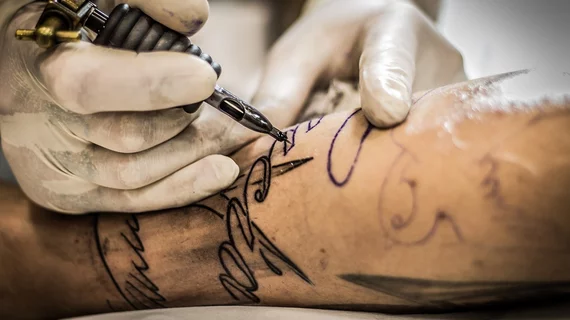Imaging considerations included in tattoo guidelines for at-risk cancer population
With the popularity of body art continuing to rise, experts are proposing new guidelines that include medical imaging for anyone with tattoos who is among the at-risk cancer population.
A new report in Cureus highlights the case of a 66-year-old man with a personal history of cancer of unknown origin. The disease was initially discovered when he presented to an emergency room with severe lower back pain and intense right upper quadrant discomfort [1]. Imaging revealed liver lesions, porta-hepatic lymphadenopathy and lytic lesions of L3 and L4 lumbar vertebrae, resulting in a stage 4, undifferentiated carcinoma of unknown primary origin.
After completing radiation therapy, follow-up CT imaging identified a new para-esophageal lymph node, which also was found to be malignant. The patient again underwent radiation therapy and responded well to the treatment.
Eight months later, surveillance PET imaging revealed swelling in the patient’s right and left axillary lymph nodes. According to the report, the patient underwent additional biopsy and was under an immense amount of stress as he awaited his results.
“... the extensive workup took a toll on the patient and his family as the fear of cancer progression with an allusive diagnosis continued to be a major factor in their lives,” explained the paper’s co-authors Dawson Foster and Joseph Sokhn, from the departments of internal medicine and hematology/oncology at St. Luke’s Hospital in Missouri.
Pathology indicated acute lymphadenitis with reactive follicular hyperplasia. Additionally, experts noted an expanded inter-follicular area mixed with histiocytes, neutrophils, apoptosis debris and an abundance of pink ink, suggesting that the lymphadenitis was secondary to tattoo ink.
The patient had recently acquired a sizeable tattoo that spanned from shoulder to shoulder across his mid/upper back. It was determined that the tattoo was responsible for the physiologic reaction.
Such cases of mistaken malignancy have become more common as the popularity of tattoos has grown in recent years. Further complicating matters is the fact that government regulation of tattoo ink is minimal, and some manufacturers fail to disclose the contents of their products, which could cause hypersensitivity and potentially be carcinogenic.
“It is difficult to predict who may develop lymphadenopathy,” the authors noted. “While these cases are rare, this example is not unique in highlighting the possible risk of acquiring a tattoo.”
The co-authors also indicated that it is difficult to predict the timeline of events (swelling, pain, etc.), as some components of tattoo ink, such as nickel and mercury, could cause delayed reactions. Uncovering the cause of lymphadenopathy, especially in the case of delayed reactions, can be a costly and anxiety-inducing process.
As such, the team suggested that patients with a personal history of cancer and those who are at elevated risk should follow guidelines when considering getting a tattoo. They offered the following recommendations:
New tattoos should be a shared decision process between patients and physicians, with physicians providing insight into the possible side effects specific to lymphadenopathy.
The desired location for the tattoo should be disclosed so that providers can identify lymphatic clusters that could be affected.
Surveillance imaging should be done immediately before acquiring new tattoos to establish a baseline that can be compared to future imaging to assess changes in lymph nodes. Radiologists should also be made aware of new tattoos and their location.
Individuals should learn the specifications of the tattoo ink being used. Certain components carry greater risk, and some could cause delayed reactions, which could affect image findings.
In this case, the patient’s acute lymphadenitis was found to be benign, but not before it caused a great deal of anxiety and an extensive workup.
The full report can be viewed here.



